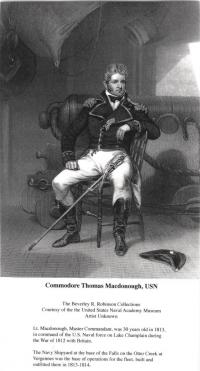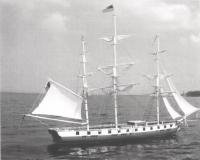
Serving the Vermont Champlain Valley Area for 45 Years
Main SectionsFront Page SportsValley VitalsIt's in the StarsStarwiseArchivesLinksAbout The VoiceContact Us |
Getting to Know Commodore Thomas MacdonoughTuesday September 1, 2009 By Cookie Steponaitis The Vergennes Union High School gymnasium and busses all proudly bear the writing, “Home of the Commodores,” and an impressive granite monument in the town square pays tribute to the man, but just who was Commodore Thomas Macdonough and what was his role in linking Vergennes, Otter Creek and Lake Champlain to a pivotal series of events in American history? Thomas Macdonough was born in Delaware in 1783 and was aboard his first ship in the US Navy at the age of sixteen. His mother and grandfather died when he was eight and his father passed three years later. History tends to record him as a modest man of few words. He was all about duty, quiet courage, and a softer style of leadership than many of his time. The Navy was his life but his own personal life was plagued by death and tragedy. Macdonough’s first sea battles occurred off the coast of Algiers and Morocco during 1802-1803 where he engaged the Barbary Pirates. US merchant vessels and seamen were being seized and held for ransom. In 1803 he earned recognition for his role in an exploit. Along with a small band of volunteers, he sailed under the cover of night into the harbor at Tripoli, boarded a fully manned pirate vessel and burned it. Ordered to Middletown, Connecticut in 1806, and the now Lieutenant Macdonough, was placed in charge of supervising construction of four 55 feet gunboats. During this time President Thomas Jefferson ordered the construction of some 173 gunboats for the growing US Navy. While he was in Middletown, Macdonough met and married Lucy Ann Shaler. Assigned to the U.S. Navy 105 foot 18 gun sloop Wasp, Macdonough patrolled the US coast enforcing the Embargo Act of 1807. His mission was to stop the seizure of cargo and crew by the English and French who were committed to attacking any vessel trading with the enemy. During 1812, events escalated when President Madison declared war on Britain and in September Macdonough took command of a fleet of gunboats in Portland, Maine. Less than a month later, at the age of 29, Macdonough was ordered to Lake Champlain to take command of the US Navy ships on the lake. Arriving in late October he found to his dismay two gunboats half sinking at Basin Harbor. In addition to this the British had staged a raid that year in Burlington, burned buildings, captured private vessels and left the American fleet in no shape to meet any enemy. Finding it difficult to do much more than repair his small fleet, Macdonough moved his young bride to Burlington and settled into his command. The control of the Lake was at stake and there was a race to build a fleet. Locations available to Lt. Macdonough included Whitehall, N.Y., Burlington, Shelburne and Vergennes. The advantages of the Vergennes site included location and availability of resources. Located just over seven miles up Otter Creek, it had natural protection from raids. The town possessed a small ship yard, a blast furnace, an air furnace, eight forges, rolling miles, a wire factory, a grist mill, and access to timber and iron ore. The Monkton Iron Works, located at the falls in Vergennes could produce seven tons of iron, three tons of sheet iron and twelve tons of shot in a week. He quickly set about hiring the talents of Master shipbuilders Noah and Adam Brown who came from New York City. Macdonough’s main ship, the 26 gun corvette Saratoga was built in forty days from the cutting of the timber to launch. Construction began on March 2, 1814 and the ship launched on April 11, 1814 and to this day the astonishing speed of the construction stands as a testimony to the work ethics and efforts of all involved. The 20 gun brig Eagle was completed at even a more hectic pace. Timber was cut on July 23, 1814 and the ship launched in nineteen days on August 11th. During the spring six of the total ten gunboats were also completed at the basin. While the American fleet was under construction, the British were busy attacking Plattsburgh in “Murray’s Raid” where homes, barracks, arsenals and blockhouses were burned. The British also attacked Swanton and other areas making the British presence not only a reality, but a terrifying presence for the people and Macdonough. In addition to building a fleet, Macdonough had to recruit seamen from this area. Since there was a shortage of able bodied sailors in the region, he signed on a collection of men, musicians, convicts and at least one woman, who were assigned to the brig Eagle. On May 14, 1814 the British attacked Fort Cassin at the mouth of Otter Creek in an attempt to sink the American fleet and block them from entering the broad lake. Macdonough had prepared for this plan and had an earthen fort at the mouth of Otter Creek and had placed cannon there manned by sailors, artillerymen and soldiers. When the attack came under the command of Captain Pring, the British officer used his 16 gun brig Linnet and eight gunboats. Meeting the attack were also 1,000 militiamen from Addison, Chittenden and Franklin counties. Captain Pring decided against landing his men because, “There seemed to be a Jonathan behind every tree.” (Jonathon was the slang term used by the British for Americans.) The battle tested not only Macdonough’s readiness, but reaffirmed the wise decision to build his fleet upriver and away from the main British fleet. Diaries of 19 year old Joseph Dulles and James Potter provide a rare look at the impressions the men had of Macdonough in the days leading up to the battle. Exactly one month prior to the Battle of Plattsburgh Dulles writes, “When Macdonough boarded the flagship, the “greatest silence” occurred. The Commander behaved very politely, but spoke very little, for he has a fine countenance and what is much more is a most amiable man, no less loved than esteemed by his officers and crew… the officers put the most unbounded confidence in his bravery and prudence. His manner is all mildness.” Potter added, “Macdonough gave the signal for attention before grace was asked; this motion of his hand and his countenance was the most beautiful and expressive gesture I ever saw; there was something particular in his look and the wavering of his hand I cannot hit. The motion is still before me.” On August 31st British troops attacked and overran the Americans at Plattsburgh. Macdonough moved his fleet to Plattsburgh, having to row and tow his ships all the way because of light headwinds. He anchored his ships at Cumberland Head knowing that he had superiority in short range cannons and thus be able to force the British navy ships to sail into the bay. He anchored all his ships on Spring lines, which allowed them to turn 180 degrees and bring fresh guns to bear from the opposite side. The British forces were under the command of Commodore George Downie and he had a 36 gun frigate Confiance, the 16 gun brig Linnet, two 11 gun sloops Chub and Finch, and twelve gun boats. Macdonough’s fleet at anchor consisted of the 26 gun Saratoga, the 20 gun brig Eagle, the 17 gun schooner Ticonderoga, a small 7 gun sloop Preble, and ten gun-boats. The battle began at 9:00 a.m. and Macdonough openly remarked that if American forces were defeated, “The British army was sure to make its way unobstructed to Albany, possible to New York and could dictate the terms of a ignominious peace." In a battle that lasted two hours and twenty minutes the British struck their colors and surrendered. During the battle, the two fleets came within three hundred yards of each other and both suffered significant loss of lives. Macdonough carried the wounded of both sides to a hospital at Crab Island and personally supervised the sinking of the remaining British fleet. In his report to the Secretary of the Navy Macdonough reported, “Sir, the almighty has been pleased to grant us a signal victory on Lake Champlain, in the capture of one frigate, one brig, and two sloops of war of the enemy. 52 US killed and 58 wounded. 260 British killed and wounded.” History has looked back on this battle as a turning point in American history. Winston Churchill called it, “The most decisive engagement of the war,” and President Theodore Roosevelt remarked on Macdonough, “Down to the time of the Civil War he is the greatest figure in our naval history.” There is no doubt that the balance of the peace negotiations was shifted after the American victory and the Treaty of Ghent was signed on Christmas Eve of 1814.” Promoted to the rank of Commodore, MacDonough continued his duty and service to the US Navy and died on August 24th, 1825 at the age of 41. It is impossible to analyze what would have happened on that fateful day had the British been victorious, but one fact remains clear. The coming together in history of Vergennes, Otter Creek, Lake Champlain and Commodore Thomas Macdonough is pivotal in the telling of the early days of the new nation and forever link this part of Vermont to national history with power and pride.
|
AdvertisementsSearch our Archives |
Agricultural Weather Forecast:

© 2006-18 The Valley Voice • 656 Exchange St., Middlebury, VT 05753 • 802-388-6366 • 802-388-6368 (fax)
Valleywides: [email protected] • Classifieds: [email protected] • Info: [email protected]


 Printer Friendly
Printer Friendly